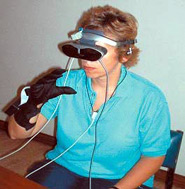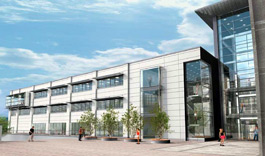| 2005 |

|
YEAR BOOK |
University of Ulster
|
Centre for Rehabilitation Research:
A First in Ireland
|
This development represents the latest acknowledgement of the quality of research being carried out by the dedicated team who now form the Health and Rehabilitation Sciences Research Institute, which was formally launched on 1 October 2004. With its origins in the University's Health Sciences Research Group (originally established in 1989 to address the lack of research in physiotherapy), this team now has an impressive track record in terms of publications, grant income and international collaborations. In the intervening 16 years, research within health sciences achieved the highest ratings for "physiotherapy" research awarded at both the 1996 (3b) and 2001 (4) UK Research Assessment Exercises (RAE).
Since 1989, the research focus has widened considerably, with the Institute now representing the largest multidisciplinary research grouping in the UK or Ireland within the Allied Health Professions (AHPs). Three key areas are now recognised as the primary focus for the Research Institute's activities.
Rehabilitation Interventions
This represents an important clinical area, and a major cost to the National Health Service, and to wider society. Current research as part of this theme includes randomised clinical trials on musculoskeletal and chronic painful conditions (including low back pain and fibromyalgia), neurological disorders (such as stroke and multiple sclerosis), and on cardiorespiratory conditions such as cystic fibrosis and chronic obstructive pulmonary disease.

Electrotherapy, Complementary & Alternative Medecine (CAM)
Complementary therapies and alternative medicines are increasingly employed in the management of intractable and chronic conditions. The group has a well-established international reputation in this area, initially based on analgesic effects of electrophysical agents. Current research includes epidemiological studies on the use of CAM and electrotherapies (including electrostimulation and laser therapy), and the completion of randomised controlled trials on acupuncture, laser acupuncture, reflexology, and transcutaneous electrical nerve stimulation (TENS).
Developing and Emerging Rehabilitation Technologies
This is a particularly exciting area of development for the Institute which includes the application of pressure care mapping technologies in the assessment and management of high interface pressure in healthcare, e.g. in order to reduce risk of pressure ulcers in high risk groups. Another example of emerging technology developing within the Institute is rehabilitation using Virtual Reality Technology (VRT)
VRT offers much promise as a novel element of therapeutic programmes in a range of areas; emerging research within the group principally includes the development of VRT to enhance the effectiveness of rehabilitation for neurological conditions in adults and children, e.g. stroke and cerebral palsy. Members of the Health & Rehabilitation Sciences Research Institute and University colleagues in the field of medical informatics have launched a pilot study employing a low cost, virtual reality system, which allows people with a stroke to be immersed in a virtual world.
The new technology will involve the patient wearing a head mounted display which provides a sense of immersion into a virtual world. The world could be a representation of an environment with which the patient is familiar, such as a kitchen, living room or supermarket, enabling the practice of movements needed to carry out daily chores. The patient will also be wearing a flexible glove connected to position and orientation sensors and a number of additional sensors will be attached to the patient's shoulder. These will enable the patient's hand and arm movements to be tracked in the virtual environment-providing visual feedback to the patient. Audio feedback in the form of a "virtual physiotherapist" is also possible, offering encouragement and motivation during the tasks.
Again this is another tremendously exciting project for the Health and Rehabilitation Sciences Research Institute, one which is unique in the UK and Ireland, and hopefully will lead to a new form of rehabilitation therapy which will considerably improve the quality of life for people with stroke.

|
|
Further information may be obtained from Professor Suzanne McDonough, Health and Rehabilitation Sciences Research Institute, University of Ulster at Jordanstown, Shore Road, Newtownabbey, Co Antrim BT37 0QB; Tel: 00 44 28 903 66900 E-mail: [email protected]